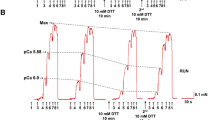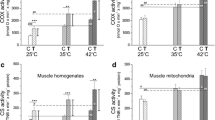Summary
Male rats, aged 17 weeks at the end of experiments, were divided into four groups. Two groups lived in normal cage conditions with or without extra load (20% of the body weight) and two groups were trained by running with or without extra load for 8 weeks. Oxidation rates of succinate, glutamate + malate, palmitoylcarnitine, and pyruvate, and the activities of lactate dehydrogenase, citrate synthase, isocitrate dehydrogenase and cytochrome oxidase were measured in homogenates of the right ventricle and in those of the subendocardial and subepicardial layers of the left ventricle. Oxidation rates of succinate and palmitoylcarnitine tended to be higher in the subendocardium than in the subepicardium of sedentary control animals (p<0.1 and p<0.05, respectively). Transmural differences of succinate and palmitoylcarnitine oxidation rates were even more clear after running training (p<0.01 and p<0.05, respectively), after carrying extra load (p<0.001 and p<0.001, respectively) and after training carrying extra load (p<0.001 and p<0.05, respectively). Training also enhanced pyruvate oxidation rate in the subendocardium. Oxidation rates of all substrates were lower in the right ventricle than in the left ventricle. In control animals there were no regional differences in the myocardial enzyme activities and the training- or extra-load-induced changes were modest compared with the changes in the oxidation rates. The most significant change was the training-induced enhancement in the lactate dehydrogenase activity of the subendocardium (p<0.001 vs subepicardium). These results show greater subendocardial than subepicardial oxidation rates of certain substrates in the normal heart. These results also suggest that the myocardium adapts to increased work by increasing the subendocardial oxidation rate of some but not all substrates, indicating further that there may be qualitative mitochondrial differences in the different regions of the heart.
Similar content being viewed by others
References
Arcos J, Sohal RS, Sun S-C, Argus MF, Burch GE (1968) Changes in ultrastructure and respiratory control in mitochondria of rat heart hypertrophied by exercise. Exp Mol Pathol 8:49–65
Baldwin KM, Cooke DA, Cheadle WG (1977) Time course adaptations in cardiac and skeletal muscle to different running programs. J Appl Physiol 42:267–272
Baldwin KM, Winder WW, Holloszy JO (1975) Adaptation of actomyosin ATPase in different types of muscle to endurance exercise. Am J Physiol 229:422–426
Bergmeyer HU (1983) Methods of enzymatic analysis, vol 2. Verlag Chemie, Weinheim
Bersohn MM, Scheuer J (1977) Effects of physical training on end-diastolic volume and myocardial performance of isolated rat hearts. Circ Res 40:510–516
Beyer RE, Morales-Corral PG, Ramp BJ, Kreitman KR, Falzom MJ, Rhee SYS, Kuhn TW, Stein M, Rosenwasser MJ, Cartwright KJ (1984) Elevation of tissue coenzyme Q (ubiquinone) and cytochrome c concentration by endurance exercise in the rat. Arch Biochem Biophys 234:323–329
Bhan AK, Scheuer J (1972) Effects of physical training on cardiac actomyosin adenosine triphosphatase activity. Am J Physiol 223:1486–1490
Bosco C (1985) Adaptive response of human skeletal muscle to simulated hypergravity condition. Acta Physiol Scand 124:507–513
Camici P, Ursini F, Galiazzo F, Bellito L, Pelosi G, Marzilli M, L'Abbate A, Barsacchi R (1984) Different respiratory activities of mitochondria isolated from the subendocardium and subepicardium of the canine heart. Basic Res Cardiol 79:454–360
Estabrook RW (1967) Mitochondrial respiratory control and the polarographic measurement of ADP:O ratios. In: Estabrook RW, Pullman ME (eds) Methods in enzymology, vol 10; Academic Press, New York, pp 41–47
Flaherty J, O'Riordan J, Khuri S, Gott V (1978) Transmural gradients in myocardial gas tensions in regionally ischemic canine left ventricle. In: Kobayashi T, Ito Y, Rona G (eds) Recent advances in studies on cardiac structure and metabolism, Vol 12. University Park Press, Baltimore, pp 219–225
Gamble WS, LaFarge CG, Filer DC, Weisul J, Monroe RG (1974) Regional coronary venous oxygen saturation and myocardial oxygen tension following abrupt changes in ventricular pressure in the isolated dog heart. Circ Res 34:672–681
Griggs DM (1979) Blood flow and metabolism in different layers of the left ventricle. Physiologist 22(2):36–40
Grossman W (1980) Cardiac hypertrophy: useful adaptation or pathologic process? Am J Med 69:576–584
Harpur RP (1980) The rat as a model for physical fitness studies. Comp Biochem Physiol 66A:553–574
Hickson RC, Hammons GT, Holloszy JO (1979) Development and regression of exercise-induced cardiac hypertrophy in rats. Am J Physiol 236:H268-H272
Holsinger JW, Ramey CA, Allison TB (1978) Transmural gradients in ischemic canine left ventricle. Effect of blood reflow on glycolytic intermediates. In: Kobayashi T, Ito Y, Rona G (eds) Recent advances in studies on cardiac structure and metabolism, vol 12. University Park Press, Baltimore, pp 579–583
Holz J, Grunewald WA, Manz R, von Restorff W, Bassenge E (1977) Intracapillary hemoglobin oxygen saturation and oxygen consumption in different layers of the left ventricular myocardium. Pflügers Arch 370:253–258
Huisman RM, Sipkema P, Westerhof N, Elzinga G (1980) Comparison of models used to calculate left ventricular wall force. Med Biol Eng Comput 18:133–144
Ichihara K, Abiko Y (1982) Crossover plot study of glycolytic intermediates in the ischemic canine heart. Jpn Heart J 23:817–828
Kainulainen H, Ahomäki E, Vihko V (1984) Selected enzyme activities in mouse cardiac muscle during training and terminated training. Basic Res Cardiol 79:110–123
Kainulainen H, Komulainen J, Takala T, Vihko V (1989) Effect of chronic exercise on glucose uptake and activities of glycolytic enzymes measured regionally in rat heart. Basic Res Cardiol 84:174–190
Kainulainen H, Takala T, Hassinen IE, Vihko V (1985) Redistribution of glucose uptake by chronic exercise measured in isolated perfused rat hearts. Pflügers Arch 403:296–300
Kainulainen H, Virtanen P, Ruskoaho H, Takala T (1989) Training increases cardiac glucose uptake during rest and exercise in rats. Am J Physiol 257:H839-H845
Kornberg A (1955) Lactic dehydrogenase of muscle. IN: Colowick SP, Kaplan NO (eds) Methods in enzymology, vol 1, Academic Press, New York, pp 441–443
Kraus H, Kirsten R (1970) Die Wirkung von körperlichem Training auf die mitochondriale Energie-Produktion im Herzmuskel und in der Leber. Pflügers Arch 320:334–347
Lundsgaard-Hansen P, Meyer C, Riedwyl H (1967) Transmural gradients of glycolytic enzyme activities in left ventricular myocardium. Pflügers Arch 297:89–106
Mitchell JH, Wildenthal K (1974) Static (isometric) excrecise and the heart: physiological and clinical considerations. Ann Rev Med 25:369–381
Molé PA (1978) Increased contractile potential of papillary muscles from exercise-trained rat hearts. Am J Physiol 234:H421-H425
Oscai LB, Molé PA, Holloszy JO (1971) Effects of exercise on cardiac weight and mitochondria in male and female rats. Am J Physiol 220:1944–1948
Oscai LB, Molé PA, Brei B, Holloszy JO (1971) Cardiac growth and respiratory enzyme levels in male rats subjected to a running program. Am J Physiol 220:1238–1241
Penpargkul S, Schwartz A, Scheuer J (1978) Effect of physical conditioning on cardiac mitochondrial functions. J Appl Physiol 45:978–986
Peterson GL (1977) Simplification of protein assay method of Lowry et al. which is more generally applicable. Anal Biochem 83:346–356
Rupp H (1981) The adaptive changes in the isoenzyme pattern of myosin from hypertrophied rat myocardium as a result of pressure overload and physical training. Basic Res Cardiol 76:79–88
Rusko HK, Bosco C, Komulainen J, Leinonen AW, Vihko V (1987) Enhanced fast twitch fiber recruitment after extra-load training in rats. In: de Groot G, Hollander AP, Hujing PA, van Ingen Schenau GJ (eds) International Series on Biomechanics synthase, vol 7-A. Free University Press. Amsterdam, pp 52–57
Sabbah HN, Marzilli M, Stein PD (1981) The relative role of subendocardium and subepicardium in left ventricular mechanics. Am J Physiol 240:H920-H926
Schaiblc TF, Scheuer J (1985) Cardiac adaptations to chronic exercise. Progr Cardiovasc Dis 27:297–324
Spotnitz HM, Sonnenblick EH, Spiro D (1969) Relation of ultrastructure to function in the intact heart: Sarcomere structure relative to pressure volume curves of intact left ventricles of dog and cat. Circ Res 18:49–66
Srere PA (1969) Citrate synthase. In: Colowick SP, Kaplan NO (eds) Methods in enzymology, vol 13. Academic Press, New York, pp 3–5
Starnes JW, Beyer KE, Edington DW (1983) Myocardial adaptations to endurance exercise in aged rats. Am J Physiol 245:H560-H566
Suzuki Y, Kamikawa T, Yamazaki N (1981) Carnitine distribution in subepicardial and subendocardial regions in normal and ischemic dog hearts. Jpn Heart J 22:377–385
Takala TES, Hassinen IE (1981) Effect of mechanical work load on the transmural distribution of glucose uptake in isolated perfused rat heart studied by regional deoxyglucose trapping. Circ Res 49:62–69
Vihko V, Salminen A, Rantamäki J (1978) Oxidative and lysosomal capacity in skeletal muscle of mice after endurance training of different intensities. Acta Physiol Scand 104:74–81
Wallenstein S, Zucker CL, Fleiss JL (1980) Some statistical methods useful in circulation research. Circ Res 47:1–9
Whereat AF, Orishimo MW, Nelson J (1969) The localization of different systems for fatty acids in inner and outer mitochondrial membranes from rabbit heart. J Biol Chem 244:6498–6506
Whitty AJ, Dimino MJ, Alfont EA, Hughes GW, Repeck MW (1978) Transmural mitochondrial differences in myocardium. In: Kobayashi T, Sano T, Dhalla NS (eds) Recent advances in studies on cardiac structurc and metabolism, vol 11. University Park Press, Baltimore, pp 349–354
Author information
Authors and Affiliations
Additional information
Supported by a grant from the Research Council for Physical Education and Sport, Ministry of Education, Finland
Rights and permissions
About this article
Cite this article
Kainulainen, H., Komulainen, J., Leinonen, A. et al. Regional differences of substrate oxidation capacity in rat hearts: Effects of extra load and endurance training. Basic Res Cardiol 85, 630–639 (1990). https://doi.org/10.1007/BF01907897
Received:
Issue Date:
DOI: https://doi.org/10.1007/BF01907897




